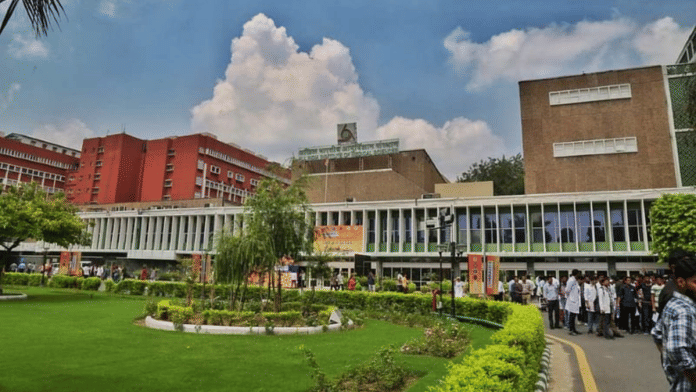New Delhi: A team of plastic and reconstructive surgeons at the All India Institute of Medical Sciences (AIIMS), New Delhi, India’s premier health facility, is gearing up to offer face transplants, one of the rarest surgeries performed anywhere in the world.
Face transplantation is a highly sophisticated procedure that has the potential to transform the life of a person with severe face deformities. It involves replacement of all or part of the face with donor tissue from someone who has died or is brain dead.
The world’s first partial face transplantation on a living person was carried out in France in 2005 while the first full face transplant was completed in Spain in 2010.
But so far, under 50 successful face transplantations have been carried out globally, and only select hospitals in the US, France, Spain, and Turkey — the only Asian country on that list — offer the complex surgery.
Sources in AIIMS, New Delhi, told ThePrint that surgeons from the institute will start undergoing training this year by performing dummy face transplants. This may be three to four years before the institute starts offering the service to actual patients.
These dummy surgeries may involve transplanting a face from a cadaver to another.
“Even though we are a government institute, tremendous work is happening at our centre in terms of offering complicated cosmetic procedures. Moreover, face transplant is something that we are keen to start in the coming years,” a senior doctor in the department of plastic, reconstructive and burns surgery told ThePrint.
“It will, however, take rigorous training before the procedure is offered to a patient as face transplant requires profound skills and coordination among team members,” the doctor said, adding that surgeons may need to visit specialised centres abroad in order to receive training for the procedure.
ThePrint explains the procedure, who can benefit from it, and the risks involved.
Also read: India logs third highest number of children not vaccinated against measles after Nigeria and Congo
Face transplants, and how they differ from facial reconstruction
A patient who has faced heavy facial disfigurement due to burn, accident or birth defects can undergo face transplantation with donated facial tissue from a deceased person.
Face transplantation is part of a field called vascularised composite allotransplantation. It involves the transplantation of facial skin, nose and the nasal structure, eyes and eyelids, lips, arteries and veins, muscles required for facial movement, nerves that provide sensation, or parts of bones supporting facial features.
However, it does not cause the patient receiving the transplant to acquire a new facial identity as in most cases, the facial tissues are grafted on the existing bone structure.
Also, the procedure has the potential to aid a person’s life by restoring functions such as swallowing, chewing, seeing, talking, smelling, and sensation in the face, as well as enhancing appearance and overall quality of life.
It is different from facial reconstruction which usually involves moving a patient’s own skin from a different body part — such as the thigh, back or chest — to the damaged parts of the face through a series of surgeries, and is aimed at restoring functionality of the face.
How face transplantation is performed
In case of a face transplantation, the donor, like other types of organ transplants, has to match immunologically with a recipient but there are other matching criteria as well. These include gender, ethnicity and skin colour.
Surgeons often use imaging technology before and during the surgery to create a model of the donor’s face, map out the finer details, develop a plan to achieve maximum aesthetic and functional results, and to guide the procedure step by step.
As part of the procedure, surgeons first remove parts such as arteries, fat, nerves, muscles and skin from a donor’s face, and then preserve and prepare them to use.
The recipient then undergoes the first part of the surgery during which their damaged skin and tissues are removed.
A crucial part of the procedure is connecting the recipient’s numerous blood vessels using tiny surgical needles. Following this, nerves and muscles are grafted. Connecting cartilages and bones is the next step and finally, soft tissues and skin are stitched together.
The procedure, depending on the requirement of every case, may take 10 to 36 hours. Sometimes, it takes tens of surgeons working together.
Face transplantation is not without its risks
Due to meticulous donor-recipient matching, preparation and planning ahead of the procedure, the survival rate of partial and full face transplant is very good (nearly 89 percent), according to scientific information available.
However, the procedure is considered high-risk and unpredictable, especially in terms of the final appearance of the recipient. Also, transplant surgeons, as of now, are not in a position to predict the response of the recipient’s immune system to the new face.
Evidence suggests that surgical and post-surgical complications in such procedures are common and many patients have been reported dead because of an infection or graft rejection during or after the surgery. For those who survive, immunosuppressant drugs and follow-ups, like in other types of organ transplants, are required for the rest of their lives.
These drugs come with an increased risk of kidney damage, cancer, diabetes and other serious health conditions.
(Edited by Radifah Kabir)
Also read: Focus on 113 home-grown, affordable medical devices to cut down import dependence, says govt






